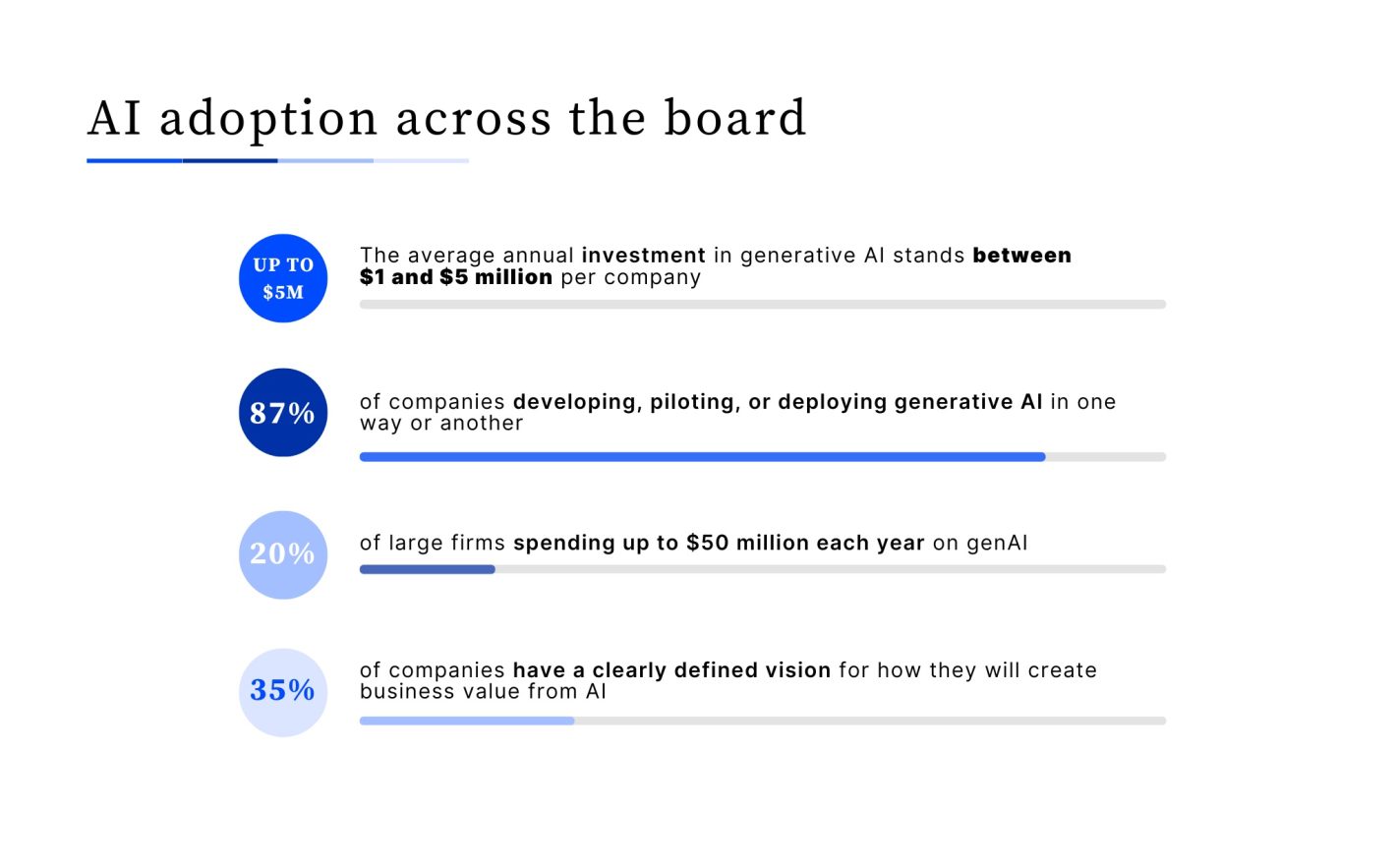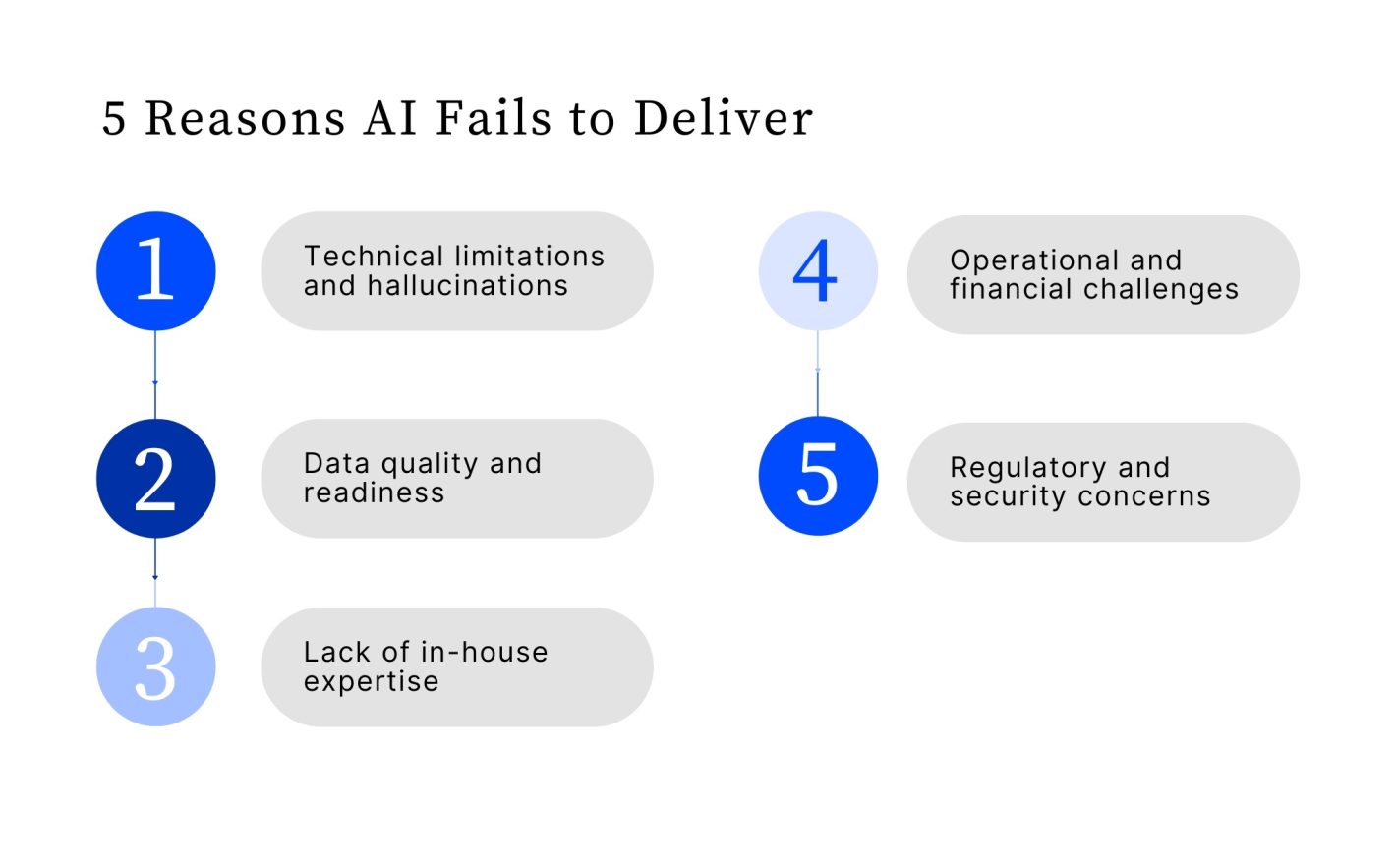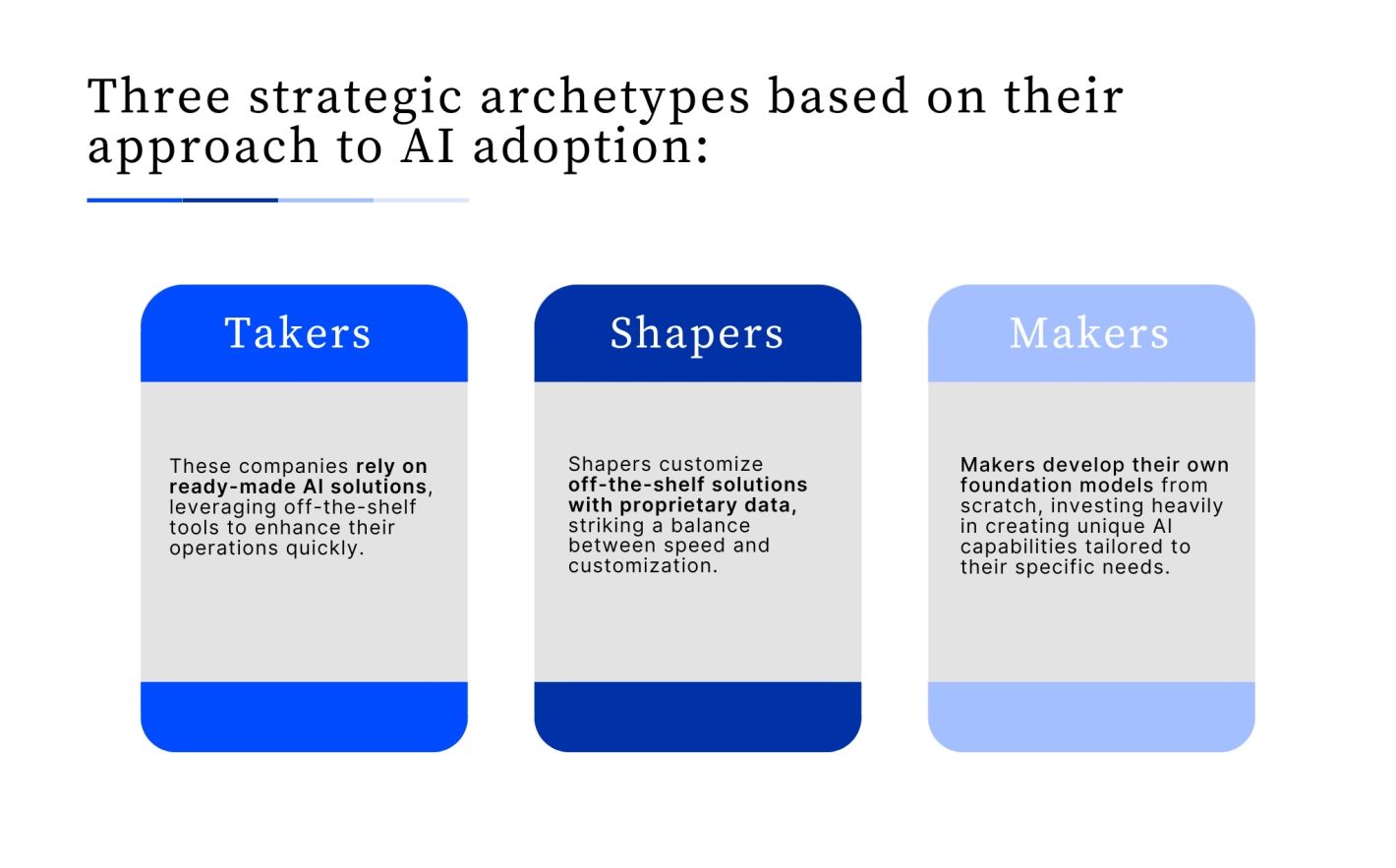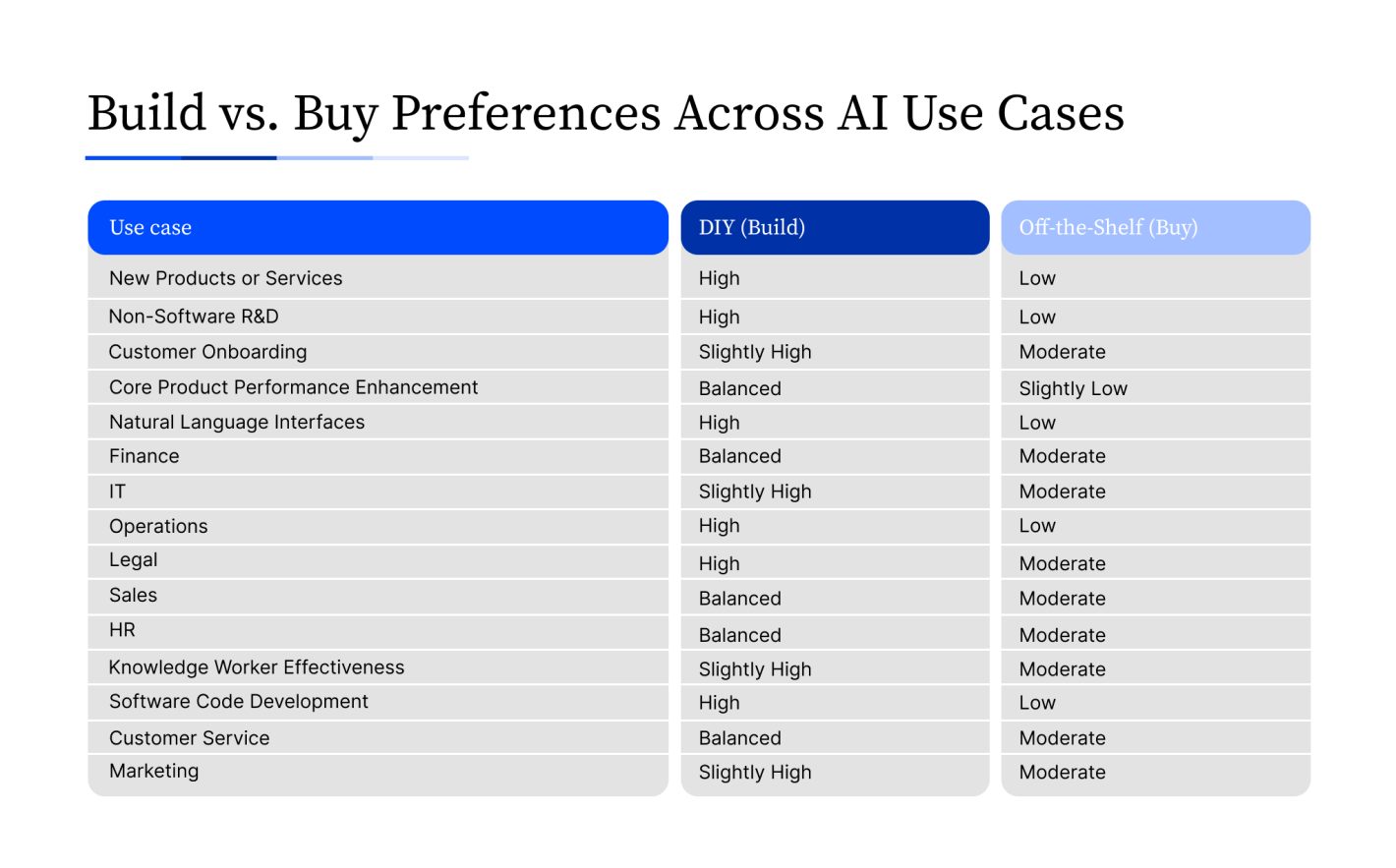It’s been a month since the start of another business season, and the big consultancies are beginning to publish their research collected from the beginning of the year. Not a surprise for any who follows the tech space—most of these reports are devoted to GenAI, AI, and related topics. This focus makes sense: last year’s boom has subsided, validated results from the field have been obtained, and some important lessons have been learned.
I’d say even more: over the last three quarters of 2024, Sombra has received nearly two dozen requests with a straightforward but really hard question.
With all this buzz around and continuous pitches about AI possibilities, many expect quick wins and substantial returns on investment. However, despite its promise, AI often fails to meet users’ expectations. This disconnect stems from misconceptions about AI’s capabilities, implementation challenges, and the nature of AI tech itself.
In this piece, I’m exploring why AI doesn’t always deliver on its promises and how businesses can better prepare to leverage this powerful tool effectively. Our analysis is based on statistics, results, and insights gathered from our work with clients, as well as market surveys, whitepapers, and various presentations.
The Business Side: Set the Clear Goals
Let’s start with the pure stats. 87% of companies developing, piloting, or deploying generative AI in one way or another, according to Bain’s survey. The average annual investment in generative AI stands between $1 and $5 million per company, and 20% of large firms spend up to $50 million each year. Impressive for me. However, despite these investments, only 35% of companies have a clearly defined vision for how they will create business value from AI. This clearly underscores a critical misalignment between AI adoption and strategic planning.

AI adoption trends
The critical point here is simple: AI is not a magical solution. It requires proper alignment with clear business objectives from the very start. AI has incredible potential, but it must be seen as a tool for solving real business problems, not just as a technology experiment. Misalignment occurs when companies approach AI after a successful pitch of AI consultants or just in a sake to follow after-market trends.
An analogy best illustrates this: using AI without a clear purpose is like trying to hammer a nail with a microscope. You can do it, of course, but why? AI, similarly, needs to be applied with precision and aimed at the right use cases. This only works when a company invests the time and resources in investigations. This preparation involves, besides market and problem investigations, also technical preparations such as structuring and managing data, assessing available resources, and establishing robust policies and procedures. Unfortunately, many organizations underestimate these prerequisites, leading to disappointment when AI projects fail to deliver the expected results.
Don’t Forget About the Tech
At this point, you could reasonably state that if the problem lies in the business area, management should simply do their homework better. Well, yes and no. The lack of real working cases for a wide audience is only the tip of the iceberg, which is totally understandable for non-tech people. If we go deeper, we’d see more challenges—tech challenges, to be precise—that only technology can solve.

5 reasons AI fails to deliver
Hallucinations
One of the most notorious problems with AI, especially with generative AI models, is the occurrence of “hallucinations.” You’re probably familiar with the term, but if not, you’ve definitely come across it while modeling. AI hallucinations are instances where the model produces false or nonsensical outputs, which can severely undermine trust in the system. For instance, AI-powered chatbots might generate responses that are factually incorrect or irrelevant, leading to frustrated customers or, in worse cases, legal complications if the AI is used in sectors like law or finance. If an organization doesn’t build its AI system correctly from the start, it will face costly issues down the road.
Data Readiness
The second major “tech” problem I would point is data readiness. It’s not enough to simply adopt AI technology—you need to ensure your organization has the proper data infrastructure in place to support it. Many businesses fail to realize this critical step, and as a result, their AI projects falter. Unstructured data or a lack of data readiness can render even the most advanced AI systems ineffective.
To fully leverage AI, companies need to invest in organizing and structuring their data. Bain’s findings emphasize that only 5% of tech companies and 3% of non-tech firms consider themselves highly prepared in terms of data readiness, security, and structure.
Expertise
Even though AI is becoming more accessible, the skills needed to implement and manage it are still in short supply. The demand for AI talent is far greater than the availability, leaving many companies unable to fully leverage their AI investments. This talent gap is a major obstacle, keeping organizations from moving their AI projects beyond the pilot phase.
Operations and Costs
My favorite point. The costs of developing, deploying, and maintaining AI systems are often underestimated. While some solutions offer a quick start, they may fall short when it comes to handling complex tasks, leading companies to more expensive in-house development. On top of that, operational support—like regular updates, security protocols, and system integration—adds layers of complexity that can chip away at the expected benefits of AI.
Regulatory
The regulatory environment around AI is changing fast. New rules, restrictions, and proposals coming out on various things – from data privacy and intellectual property to ethical AI use. Companies need to navigate these regulations carefully to avoid compliance risks. As AI systems become more embedded in business operations, these considerations are becoming increasingly critical.

AI as a Strategic Asset, Not a Plug-and-Play Solution
Don’t get me wrong, as a CEO of a service tech company, I believe that AI solutions have already shifted the landscape and continue to do so month by month. However, they shouldn’t be seen as a plug-and-play solution just yet.
The truth is, AI is much more complex and requires a deep integration into the business strategy to generate tangible results. Adoption rates for internal productivity use cases such as software code development and customer service have seen significant increases between October 2023 and February 2024. Notably, software code development adoption rose sharply, reflecting AI’s growing role in enhancing internal processes. Meanwhile, product differentiation use cases like natural language interfaces also showed a substantial jump in adoption, highlighting the expanding horizons of AI applications.
In 2023, companies were primarily exploring AI’s possibilities, running pilot projects to test its effectiveness. However, by 2024, the focus has shifted to delivering results and generating tangible business value. Bain’s survey indicates that while a significant number of companies view AI as a top priority, the challenge lies in turning pilot successes into scalable, enterprise-wide solutions. Many companies have yet to fully grasp the breadth of AI’s potential, resulting in missed opportunities and underutilized investments.

AI trends
Build vs. Buy: Navigating Your AI Options
The democratization of AI has lowered barriers to entry like never before. Implementing sophisticated AI solutions used to require significant time and financial investments. Now, thanks to vendors like Google, AWS, and Azure offering turnkey solutions, deploying and customizing AI tools has become much more accessible. However, in essence, the classic “Buy vs. Build” dilemma is reshaping the industry landscape.
Off-the-Shelf Solutions: Speed and Simplicity
For companies looking for quick wins and immediate operational improvements, these applications are an appealing choice. In the case of standardized processes such as sales, human resources, and customer service, these applications often offer extensive functionality without requiring significant modifications.
However, the one-size-fits-all nature of these solutions can be limiting. They might lack the specific features required to handle complex or unique business scenarios, especially in industries such as technology, energy, and telecommunications. While these solutions are easier to adopt, they may not fully align with the nuanced requirements of certain organizations, potentially leading to unmet expectations and suboptimal results.
Building Custom Solutions: Tailored Presicion
On the other end of the spectrum, building custom AI models enables companies to develop solutions that precisely align with their unique data sets, operational contexts, and strategic objectives. This tailored approach is particularly prevalent in sectors where specialized data and intricate workflows necessitate customized AI applications. Industries like energy, technology, and telecommunications often opt to develop proprietary models to gain a competitive edge through bespoke functionalities.
That said, the custom-build approach comes with its own set of challenges. Crafting bespoke AI solutions typically demands significant investments of time, resources, and specialized expertise. Implementation timelines are longer, and managing custom models can increase operational complexities. Despite these hurdles, companies that successfully build their own AI models often reap substantial benefits, including greater control, enhanced flexibility, and the ability to innovate beyond the capabilities of standard solutions.
Choose Your Strategy
What approach to choose depends only on your tasks and investigations that you did prior to looking for your AI. However, I like the split how McKinsey categorizes companies on their approach to AI adoption:

Strategic archetypes based on AI adoption
As the market matures, companies are adopting a hybrid approach—purchasing third-party solutions when available but investing in tailoring them to meet their specific needs. This strategy allows organizations to leverage the speed of off-the-shelf tools while maintaining the flexibility to customize where necessary. This trend reflects a desire for greater control and alignment with specific business needs.

Build vs. buy preferences across AI use cases

Instead of Conclusion: From Exploration to Value Creation
As in many fields, when you take a helicopter view of the situation, it’s clear that winning is a complex endeavor. Developing your AI solution requires a strategic approach that prioritizes data management, invests in AI talent, and continuously refines AI models to align with business goals. AI offers immense potential, but the tech is not a magic bullet itself.

Viktor Chekh, Sombra CEO
So, the next time you hear an exciting pitch about a breakthrough product, see fresh numbers from a market report, or read a successful case study about implementing AI-based technologies, my advice is to break it down.
If you’re thinking about implementing similar technologies in your organization, don’t hesitate to ask questions. With over 10 years of experience, we at Sombra believe that solutions should be pursued when they address real problems, deliver ROI, and when the organization is ready for them. Contact us, and let’s explore whether AI can help with your challenges.











